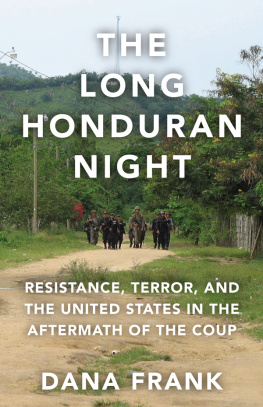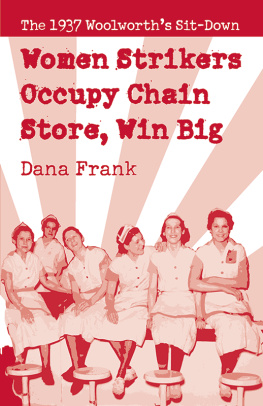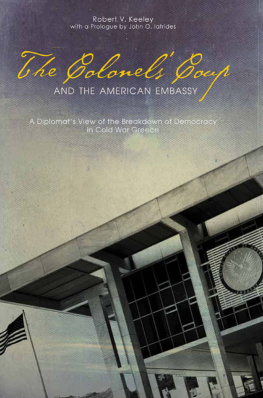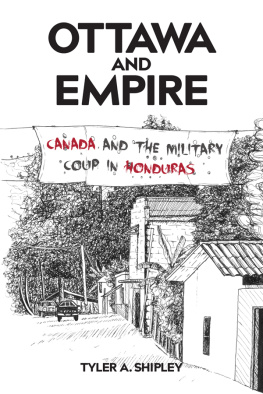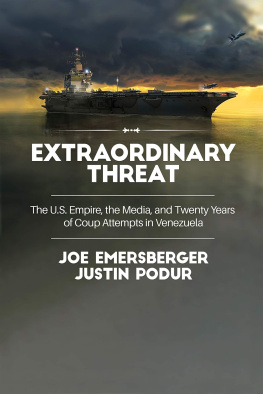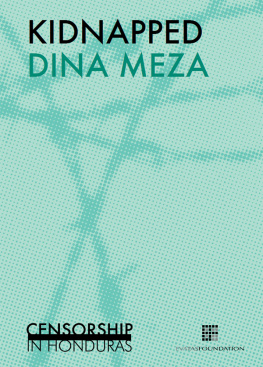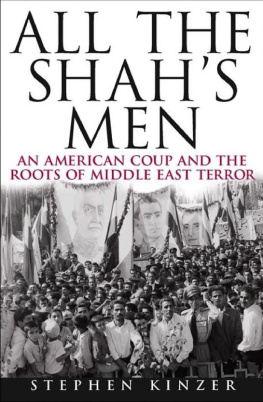PRAISE FOR THE LONG HONDURAN NIGHT
Dana Frank has written a searing portrait of a nation in crisis, a book that is startling, enraging, and humane all at once. Her most important accomplishment is never losing sight of the hardships and treachery that ordinary Hondurans have had to endure these last several years, nor the dignity with which they have survived it all.
Daniel Alarcn, executive producer of Radio Ambulante, author of At Night We Walk in Circles
The Long Honduran Night breaks the deafening silence that has followed recent American intervention in Honduras. It graphically documents the awful legacy of this intervention. By showing how directly the United States crashed into a Honduran presidential election, it also exposes the hypocrisy of our outrage at foreign interference in our own politics.
Stephen Kinzer, award-winning author and foreign correspondent
If youve any interest at all in Honduras, US foreign policy, Central America, why so many Central Americans are migrating north or in a powerful, informative, and extremely good read, do pick up Dana Franks book, The Long Honduran Night. Its a surprisingly readable book that tells not only the tragic story of another failed state and the forces that continue to work against establishing real democracies in Central America, but also inspires in its stories of everyday people in Honduras and the United Stateswho work against difficult odds to create change, often by placing their lives at risk.
Mara Martin, independent journalist
Free from academic jargon, conversant with modern Honduran history, and steeped in passion, this testimonial book is the best primer in English about the coup, and resistance to it, that destroyed Honduran democracy on June 28, 2009.... Almost ten years after the coup, Franks book transits seamlessly between the social fabric and the intimate lives of hundreds of Hondurans she has met personally during her many years in the country. Frank manages this while referencing key historical processes and their current legacies, an important and necessary feat on its own, but also valuable because it informs the current plight of Hondurans who flee their country into the US seeking asylum in the aftermath of the 2009 coup.
Dario A. Euraque, professor of history and international studies, Trinity College
I have covered Honduras ever since the 2009 coup. Dana Franks insightful and very human portrait of the countrys resistance is required reading for anyone who wants to understand whats really going on in Honduras and why it matters.
Adam Raney, journalist, Al Jazeera English and Univision
I congratulate and thank Dr. Dana Frank, a North American concerned about Honduras, for giving us this book and for documenting the role of the United States in the long night of terror that we have lived in Honduras since the 2009 coup. Her contribution to historic memory stands as our witness.
Bertha Oliva, general coordinator, Committee of the Families of the Detained and Disappeared in Honduras
THE
LONG
HONDURAN
NIGHT
Resistance, Terror, and the United States
in the Aftermath of the Coup
Dana Frank

2018 Dana Frank
Published in 2018 by
Haymarket Books
P.O. Box 180165
Chicago, IL 60618
773-583-7884
www.haymarketbooks.org
ISBN: 978-1-60846-961-1
Trade distribution:
In the US, Consortium Book Sales and Distribution, www.cbsd.com
In Canada, Publishers Group Canada, www.pgcbooks.ca
In the UK, Turnaround Publisher Services, www.turnaround-uk.com
All other countries, Ingram Publisher Services International,
This book was published with the generous support of Lannan Foundation and Wallace Action Fund.
Cover photo: Honduran military, police, and private security forces occupying the town of Guadalupe Carney, Coln, December 15, 2010. Dana Frank. Cover design by Jamie Kerry.
Library of Congress Cataloging-in-Publication data is available.

To Stephen Coats and German Zepeda,
my two pole stars.
One in the North, one in the South.
One in heaven, at peace,
One on Earth, in struggle.
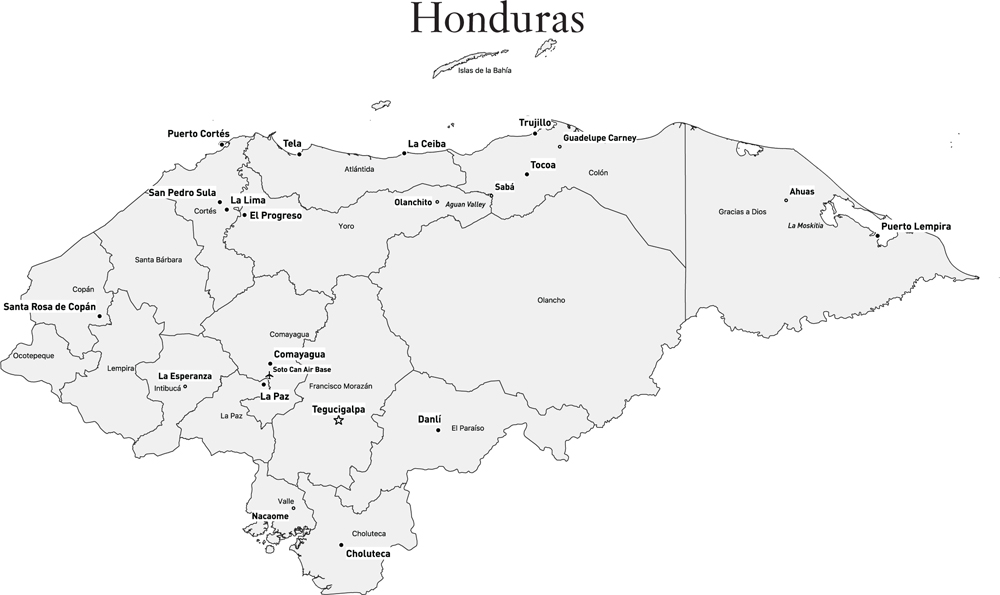
Introduction
On June 28, 2009, at 5:30 in the morning, the Honduran military deposed democratically elected President Jos Manuel Zelaya Rosales, in the first successful Latin American coup in over two decades. The armed forces flew him to Costa Rica with the full collusion of the Honduran Supreme Court and the majority of the Honduran Congress. During the weeks that followed, the Obama Administration moved swiftly to recognize and then stabilize the post-coup regime. In the face of an international outcry against the coup, the United States helped the perpetrators play out the clock until a previously scheduled election arrived in November, then recognized the outcome of a completely illegitimate electoral process controlled by the coup leaders themselvesbringing to power a vicious and corrupt post-coup regime.
This book tells the story of eight years in the aftermath of that coup: how the Honduran elites wrought havoc under their illegitimate rule and were assiduously supported by the US government, and how the Honduran people and their allies abroad, in particular in the United States, fought back. Into that larger narrative I weave my personal experiences in Honduras and Washington, D.C., as I observed joyous demonstrations in the streets of San Pedro Sula, visited a campesino town that had just been burned down by the police, pleaded with aides in the United States Congress, and tried to do my best to help stop the horror.
What difference did the Honduran coup make? There was certainly no golden age in Honduras before 2009 against which to measure it. On the eve of the coup, Hondurans were overwhelmingly But before the coup the forces of complete corruption remained at bay, the state functioned at a basic level, and the rule of law was largely intact, however bent. Most people got by, economically, albeit poor and facing marginal prospects.
Honduras had remained under tight control of the United States since the beginning of the twentieth centurya captive nation in the eyes of scholars. Beginning in the 1910s, the United Fruit Company and its counterpart, the Standard Fruit Company, largely controlled Honduran politics, as their banana plantations spread across vast enclaves over which the companies had near-complete control, with tentacles extending throughout the Honduran state and economy.
In 1954, though, fifty thousand banana workers and their allies rose up in a sixty-nine-day general strike that marked the most important moment in twentieth-century Honduran history. The strikes outcome, machinated from above by the US government, was a Cold War compromise in which strong unions were permitted to wrest concrete gains from the banana corporations and raise living standards for a sector of the working class, but only if they stayed assiduously out of electoral politics, fought Communists, and stayed silent about US domination. During the late 1950s and early 1960s, as part of its anticommunist project, the US brokered the creation of a Honduran welfare state that included a respectable system of labor lawsif usually not enforcedand a national health service and pension system that, while only covering a portion of the population, nonetheless delivered a measure of quality services.
Next page
